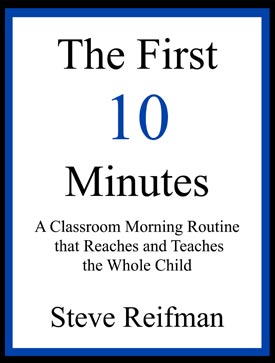Displaying items by tag: teaching the whole child
Helping Children Get Back into “School Mode†(Teaching Tip #74)
Over the past few years I have uploaded approximately twenty instructional videos on YouTube. These videos range from 1-6 minutes in length and deal primarily with academic tips and study strategies. I am excited to announce that I have re-designed my page on the site, and I am officially re-launching it as the “Teaching Kids†channel. All of my new “Teaching Kids†videos will feature 1-2 minute tips for educators and parents and will address a wide variety of topics that focus on teaching the whole child, including academics, character, and health.
The Two Voices
 In my ongoing efforts to build a classroom culture of quality and promote valuable habits of character, I am always on the lookout for ways to inspire students, bring out the best in them, and share important life lessons. Sometimes I am able to impart this type of information through a visual or a story or a photograph. For example, last school year I introduced the "Making the Choice" visual to encourage everyone to dedicate themselves to becoming more determined students, and the results were very promising. As teachers, we can never know which of these efforts will resonate with kids, so we try to find as many as possible.
In my ongoing efforts to build a classroom culture of quality and promote valuable habits of character, I am always on the lookout for ways to inspire students, bring out the best in them, and share important life lessons. Sometimes I am able to impart this type of information through a visual or a story or a photograph. For example, last school year I introduced the "Making the Choice" visual to encourage everyone to dedicate themselves to becoming more determined students, and the results were very promising. As teachers, we can never know which of these efforts will resonate with kids, so we try to find as many as possible.
This school year I started using a new strategy with my class, and because it has been working so effectively, I find myself referring to it frequently. I call this strategy “The Two Voices.†This idea pertains to the situation in which students find themselves many times every day as they work on school activities, projects, and homework. As adults, we also find ourselves in this situation frequently as we go about our work.
I tell my students that it is human nature to have two competing desires when we are doing our work. On one hand, we want to do a great job. We want our work to be neat, correct, and creative. In other words, there is a force inside each one of us that wants to produce quality work. With some children it may be difficult to see this force sometimes, but it is there, waiting to be unleashed. On the other hand, we also have the desire to be done. Oftentimes, we simply want to finish.
In my opinion, which force ends up victorious in this ongoing competition goes a long way towards determining whether kids will become quality students. If the “I want to get done†side is winning almost all the time, then we, as teachers, still have quite a bit of work ahead of us. If each side is winning roughly half the time, we are not quite there yet. If the “I will settle for nothing less than my best†side is winning all the time or almost all the time, then those students are demonstrating the desire, pride, and work ethic that will set them apart in school and in life. This latter mindset is the goal with every student.
When I introduce the concept of “The Two Voices†to my class, I start by asking everyone to imagine that there is a tiny person standing on each of my shoulders whispering something into my ears. The messages the two people are whispering are exact opposites of each other. On one shoulder the “Great Job†person is telling me to settle for nothing less than my best effort. Specifically, she is telling me to take my time, pay attention to detail, and focus on the quality of my work. Excellence, she emphasizes, is what matters. On my other shoulder the “Just Get Done†person is telling me to hurry up and get this over with already. Specifically, she is telling me not to care how my work looks, whether everything is correct, or whether it represents the best I can do. Finishing, she emphasizes, is what counts.
After introducing these two folks to the whole group, I follow up as needed. If individual children seem to be valuing completion over quality, I will meet with them privately to discuss the issue. My favorite way to follow up, though, is with the whole group. Though it is tempting to address the group whenever the class has not performed up to expectations, I try to share only positive examples.
For instance, about a month ago one girl, whom we will call Allison, asked to start a project over again because she didn’t think her first effort was good enough. I seized on this moment and later told the class how wonderful it was to see someone work with such dedication and hold herself to such high standards. Her goal, I emphasized, wasn’t to get done; it was to make her work the best it could be. Capitalizing on these learnable moments is one of the most powerful ways to create a classroom culture of quality.
The First 10 Minutes
The First 10 Minutes: A Classroom Morning Routine that Reaches and Teaches the Whole Child
Description

A consistent, effective morning routine sets the tone for the upcoming school day and prepares students for high quality learning. In The First 10 Minutes Steve describes a three-part routine that reaches and teaches the whole child. This resource is a user-friendly, 23-page PDF download.
Part 1 introduces the morning check-in, an activity that addresses the affective domain by building a sense of inclusion and mutual caring, strengthening teamwork, increasing class bonding, and helping each child feel acknowledged and valued.
Part 2 features three types of class discussions that focus on moral and character development and emphasize strong work habits and social skills. The goals of these brief conversations are to inspire children to maximize their amazing potential, build a sense of purpose, and increase student motivation to learn and succeed.
Part 3 adds a physical component to this routine that both energizes and de-stresses children to help them achieve an ideal mindset for academic learning. After completing this warm-up routine, students will be calm, relaxed, focused, and confident.





